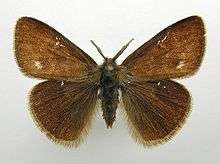Orgyia antiquoides
| Orgyia antiquoides | |
|---|---|
 | |
| Male | |
| Scientific classification | |
| Kingdom: | Animalia |
| Phylum: | Arthropoda |
| Class: | Insecta |
| Order: | Lepidoptera |
| Family: | Lymantriidae |
| Genus: | Orgyia |
| Species: | O. antiquoides |
| Binomial name | |
| Orgyia antiquoides (Hübner, 1822) | |
| Synonyms | |
| |
Orgyia antiquoides is a moth of the Lymantriidae family. It is found in most of Europe, the Ural, Armenia, Mongolia, and China.

Cocoon in which the pupa, female and eggs live
The wingspan is 20–24 mm for males. The females are wingless. Adult males are on wing from July to early September in one generation in western Europe.
The larvae feed on Rubus chamaemorus, Sorbus aucuparia, Calluna vulgaris, Vaccinium uliginosum, Andromeda polifolia, and Empetrum nigrum. Larvae can be found from May to July. Pupation takes place in a conspicable yellow cocoon. The females live in the cocoon and deposit the eggs there. The species hibernates as an egg.
External links
This article is issued from Wikipedia - version of the 11/19/2016. The text is available under the Creative Commons Attribution/Share Alike but additional terms may apply for the media files.